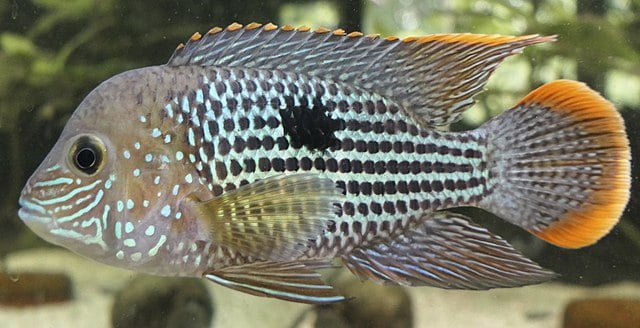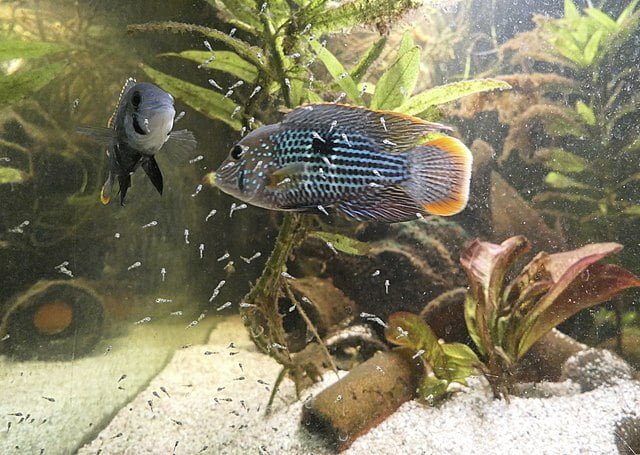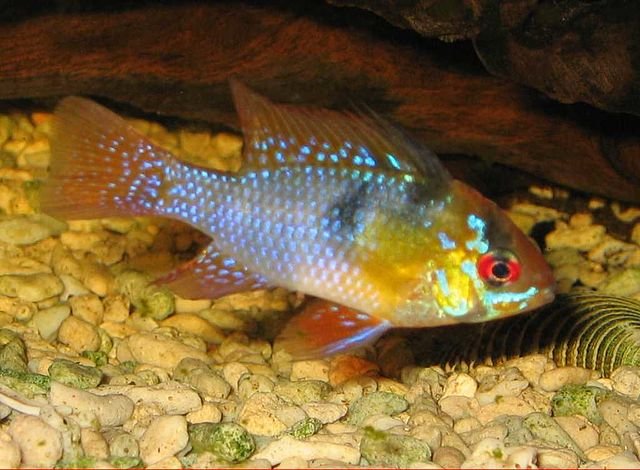
Green Terror Cichlids (Andinoacara rivulatus), native to South America, are renowned for their vibrant colors, impressive size, and intriguing behavior.
The Green Terror fish is marketed worldwide as an aquarium pet; however, it also represents a significant source of food and employment for populations in Peru and Ecuador (Nirchio et al., 2020), where it is known as “Vieja Azul.”
Discover in this article the care needs, breeding habits, feeding preferences, and advances in the aquaculture of these fish. Whether you’re an experienced aquarist or a curious beginner, this comprehensive guide will provide you with the necessary knowledge to successfully maintain and appreciate these extraordinary fish.
Biology of the Green Terror Fish
- 1 Biology of the Green Terror Fish
- 2 Care of Green Terror Fish
- 3 How to Breed Green Terror Fish?
- 4 Feeding Green Terror Fish
- 5 Compatibility of Green Terror Cichlids
- 6 Blue Vieja Aquaculture
- 7 Diseases Affecting Green Terrors
- 8 Streptococcosis
- 9 Conclusion
- 10 Bibliographical References
- 11 Entradas relacionadas:
Taxonomy
Kingdom: Animalia
Phylum: Chordata
Class: Actinopterygii
Subclass: Neopterygii
Infraclass: Teleostei
Superorder: Acanthopterygii
Order: Perciformes
Family: Cichlidae
Genus: Andinoacara
Species: Andinoacara rivulatus (Günther, 1860)
Synonymy: Aequidens rivulatus, Chromis rivulata
Common name in Spanish: Terror verde, mojarra (Peru), Vieja azul (Ecuador)
Common name in English: Green Terror
Distinctive Features
- Vibrant Coloration: Green Terrors are adorned with a fascinating array of colors, ranging from iridescent greens to deep blues and flashes of red. Their bodies are adorned with intricate patterns, enhancing their captivating appearance.
- Impressive Size: These cichlids can grow up to 14 inches (35 cm) long, making them an imposing presence in the aquarium. Their robust bodies and powerful fins further accentuate their impressive stature. It’s important to note that male Green Terrors grow faster and larger than females. On average, a male can reach 30 cm (12 inches), while females can grow up to 15 cm (5 inches).
- Body Shape: Green Terror fish have a tall, laterally compressed body. Adult male Green Terrors eventually develop a hump. In addition to size, a difference between males and females is the shape of the fins; in males, the dorsal and anal fins are longer, and the caudal fin is reticulated.
- Unique Patterns: Each Green Terror displays a unique pattern of scales, creating an individual identity within the species. These patterns evolve with age, enhancing their ever-changing beauty.
- Life Expectancy: The Vieja Azul has a life expectancy of 7 to 10 years in captivity.
Natural Habitat
The Green Terror Cichlid (Andinoacara rivulatus) is naturally distributed from the Esmeralda River in Ecuador to the Cañete River in Peru. However, this fish has been introduced to Australia (Corfield et al., 2008), the Brantas River in Indonesia (Serdiati et al., 2020), and the Amacuzac River in Mexico (Cordero-Martínez et al., 2022).
Green Terror fish are benthopelagic cichlids that inhabit the lower reaches of slow-moving rivers and shallow lakes; they also stay in areas with abundant vegetation.
Care of Green Terror Fish
Green Terror cichlids are resilient fish; therefore, you shouldn’t have any problems in their care if you maintain the parameter conditions listed in Table 1.
Table 01. Technical data sheet for breeding Green Terror fish (Andinoacara rivulatus).
Stay Always Informed
Join our communities to instantly receive the most important news, reports, and analysis from the aquaculture industry.
| Parameter | Range |
|---|---|
| Tank Volume | 208 liters (55 gallons) for a pair. |
| Water Temperature | 24 to 28°C (75 to 82°F) |
| pH | 6.5 to 7.5 |
| Water Hardness | 25.0 dGH |
| Ammonia | 0.125 mg/l |
| Water Change | 25% per week. |
- Proper Decoration: Provide caves, rocks, and driftwood to create hiding spots and territories. Live plants (40% of the water surface) are also appreciated, adding natural beauty and improving water quality.
On the other hand, if you need to handle the fish for health monitoring or transportation, you can use 10 ml/L of clove oil (Syzygium aromaticum) to induce deep sedation in the fish (Sorroza et al., 2020).
How to Breed Green Terror Fish?
Reproductive Behavior
Green Terror fish reach sexual maturity at approximately 18 cm in length and an average weight of 60 to 80 grams; in males, sexual maturity is evidenced by the formation of the “hump.” The sex ratio is 1:1 male-female. Below are the most important characteristics of reproductive behavior:
- Pair Formation: Green Terror Cichlids form monogamous pairs and exhibit elaborate courtship rituals. Males display their vibrant colors and perform territorial dances to attract females. Li et al., (2022) report that male Green Terrors primarily choose females to mate with based on body size, behavioral intention, and appearance, while female preferences include body size, appearance, and behavioral intention.
- Nest Building: The chosen breeding site is usually a flat surface, which the pair cleans and prepares for egg deposition.
- Egg Laying: The female lays a large number of eggs, typically between 200 and 800. The male fertilizes the eggs as the female lays them.
- Hybridization: Nirchio et al., (2020) highlight that Green Terror fish have occasionally been crossed with “Blue Acara” Andinoacara cf. pulcher to obtain hybrids with the size and coloration of A. pulcher and the orange veins of An. rivulatus, both in the dorsal and caudal fins.
Rearing Green Terror Fry
- Parental Care: Both parents exhibit dedicated parental care, protecting and ventilating the eggs to ensure adequate oxygenation. In this regard, Hu et al., (2022) report that A. rivulatus shows a high degree of parental care and an obvious pattern of larvae and fry protection when faced with an intruder.
- Free-Swimming Fry: Güngör (2012) reports that egg incubation lasts approximately 75 hours, after which the larvae have an average length of 4.26 mm and begin feeding on the fifth day. Additionally, Moshayedi et al., (2014) described the early development of Green Terror fish in four stages: eleuthero-embryo (up to 120 Hph along with yolk sac absorption), propterygio-larva (156 Hph), pterygio-larva (570 Hph), and Juvenile. Furthermore, if you want to obtain male-only populations of Green Terror fish, you can use 250 mg/kg of 17α-methyltestosterone in the fry’s diet (Wang et al., 2023).
- Separate Fry Tank: Consider installing a separate fry tank to provide a safe and controlled environment for developing fry.

Feeding Green Terror Fish
Nutritional Needs
- Carnivorous Diet: Green Terrors are carnivores (some researchers describe them as omnivores) and require a protein-rich diet. Live food options such as worms, crickets, and small fish are ideal. These cichlids also accept pieces of oysters, mussels, shrimp, and fish.
- Commercial Pellets: High-quality cichlid pellets can supplement the diet, providing essential vitamins and minerals.
- Variety is Key: Offer a variety of food sources to ensure a balanced and nutritious diet.
Feeding Recommendations
- Feed Adults Twice a Day: Provide two feedings per day to adult Green Terrors, offering an amount they can consume in a few minutes.
- Adjust Feeding for Larvae and Fry: Güngör (2012) reports that larvae open their mouths at 5 days old and should be fed Artemia nauplii, while only starting to receive powdered food along with Artemia at the second week. Moreover, Jamali et al., (2018) studied the effects of feeding Neotropical Green Terror cichlid (A. rivulatus) larvae with a commercial diet and enriched Artemia franciscana nauplii with lecithin (EN) and concluded that feeding regimes of 10 and 5 days with enriched Artemia could improve larvae survival and growth. As for fry, they should be fed more frequently, up to 5 or 6 times a day, as they require smaller portions.
- Breeder Feeding: Feeding and nutrition of Green Terror cichlid breeders are key aspects to produce quality fry and larvae. In this context, Jamali et al., (2019) investigated the effects of bioencapsulated soy lecithin in adult Artemia franciscana combined with an inert diet on reproductive performance in Aequidens rivulatus (Green Terror cichlid).
- Avoid Overfeeding: Overfeeding can lead to water quality issues and health problems for the fish.
Compatibility of Green Terror Cichlids
- Intelligent Fish: Green Terrors are known for their intelligence and inquisitive nature. They enjoy exploring their environment and interacting with it.
- Active Swimmers: These cichlids are constantly on the move, patrolling their territory and displaying their agility. Their active swimming patterns add a dynamic element to the aquarium.
- Territorial Potential: Green Terrors can be territorial, especially during the breeding season. Providing ample space and suitable tank mates is essential to minimize aggression. Some fish that can be bred alongside Green Terrors are “Blue Acara,” plecos, and Oscar fish.
Blue Vieja Aquaculture
Currently, blue vieja aquaculture is being promoted in Ecuador as an alternative fish supply for coastal populations; however, aquaculture experiences have been conducted on a pilot basis in cages, recirculation systems, and biofloc.
Furthermore, experiences are being conducted in feeding Blue Terror fish using fruit by-products (e.g., passion fruit) for diet formulation, but an appropriate formulation for each stage of their life cycle has not yet been established.
Green Terror fish constitute an important nutritional source. González et al., (2016) report that this fish has a fillet yield of 33.94%, with a proximal composition of 22.43% protein, 4.17% fat, 1.55% ash, and 74.65% moisture.
Diseases Affecting Green Terrors
Like all fish, Green Terrors are susceptible to diseases. Keeping a clean aquarium, monitoring water parameters, and quarantining newcomers can help prevent disease outbreaks.
Streptococcosis
Streptococcosis is a bacterial disease that affects marine and freshwater fish. The Green Terror is not exempt from this disease. Luo et al., (2024) revealed that the main symptoms of streptococcosis in the green terror fish (Aequidens rivulatus) include scale loss, skin ulceration, and slight bleeding; also, they highlight that histopathological observation revealed evident damage to the liver, spleen, and kidneys of the fish; and Streptococcus iniae causes it.
Skin ulcers
Shi et al., (2025) reported that an Andinoacara rivulatus specimen developed an unexplained skin ulcer disease, which severely affected its ornamental value in a farm in Liaoyang (China); and identified the bacterium Klebsiella pneumoniae as the main cause. The main pathological changes included lamellar deformation of the gills, epithelial cell hyperplasia, spleen congestion and hepatic vascular injury, and the degree of pathological changes was related to the infection dose.
Parasites
Rahmati-Holasoo et al., (2023) report the presence of the endoparasite Capillaria sp. in the intestines of Green Terror fish raised in Iran; researchers treated the remaining fish by administering levamisole for 48 hours every 7 days for 28 days to eliminate the parasites.
Conclusion
As you embark on your journey with Green Terror cichlids, remember that these extraordinary fish demand respect and dedication. You’ll witness their captivating beauty, intriguing behavior, and remarkable resilience by providing them with a suitable environment, proper care, and a balanced diet. Embrace the challenge and reap the rewards of nurturing these captivating South American jewels.
Green Terrors are not just fish; they are captivating companions that enrich the aquatic world. If you commit to their well-being, you’ll uncover the wonders of these South American gems and experience the profound joy of nurturing their enigmatic charm.
Bibliographical References
Cordero-Martínez, G., Mercado-Silva, N., García-de-Jesús, S., Arce, E., Ramírez-Ponce, A., & Mejía-Mojica, H. (2022). Specific and taxonomic diversity of the ichthyofauna of the Amacuzac River, Morelos, Mexico. Revista de Biología Tropical, 70(1), 290-306.
Corfield, J., B. Diggles, C. Jubb, R. M. McDowall, A. Moore, A. Richards, and D. K. Rowe. 2008. Review of the impacts of introduced ornamental fish species that have established wild populations in Australia. Final Report. Department of the Environment, Water, Heritage and the Arts, Australia
González, M., Rodríguez, J., López, M., Vergara, G., & García, A. (2016). Estimación del rendimiento y valor nutricional de la vieja azul (Andinoacara rivulatus). Revista de Investigación Talentos, 3(2), 36-42.
Güngör, F. (2012). Bir çiklit balığı türü olan Aequidens rivulatus (Günther, 1860)’un üreme ve larval gelişiminin incelenmesi (Master’s thesis, Fen Bilimleri Enstitüsü).
Hu, Y., Cai, Q., Wang, R., Lu, H., Ma, Z., & Liu, Y. (2022). The behavioural pattern and variation in parental care of Aequidens rivulatus. Aquaculture Research, 53(4), 1404-1412.
Jamali H, Ahmadifard N, Noori F, Agh N, Gisbert E. Improving co-feeding strategies for Neotropical green terror cichlid (Aequidens rivulatus) larvae with lecithin-enriched Artemia franciscana nauplii: Effects on survival, growth performance and body composition. Aquac Res. 2018; 49: 3909–3918. https://doi.org/10.1111/are.13861
Jamali, H., Ahmadifard, N., Noori, F., Gisbert, E., Estevez, A., & Agh, N. (2019). Lecithin-enriched Artemia combined with inert diet and its effects on reproduction and digestive enzymes of Aequidens rivulatus. Aquaculture, 511, 734253.
Li, H., Wang, J., Zhang, X., Hu, Y., Cai, Q., Liu, Y., & Ma, Z. (2022). Sex Differences in Mate Choice Preference Characteristics of Aequidens rivulatus. Animals, 12(9), 1205. https://doi.org/10.3390/ani12091205
Luo, Z., Bai, X., Hao, S., Wang, M., Wu, Y., & Sun, H. (2024). Two Genotypes of Streptococcus iniae Are the Causative Agents of Diseased Ornamental Fish, Green Terror Cichlid (Aequidens rivulatus). Fishes, 9(4), 140. https://doi.org/10.3390/fishes9040140
Moshayedi F, Eagderi S, Ghorbanzadeh G. The study of Allometric growth patterns and morphological development of the Green terror (Aequiden srivulatus: Cichlidae) during early development. JAIR 2014; 1 (4) :1-10 URL: http://jair.gonbad.ac.ir/article-1-163-en.html
Nirchio, M., Paim, F. G., Britzke, R., Rossi, A. R., Milana, V., & Oliveira, C. (2020). Molecular analysis and chromosome mapping of repetitive DNAs in the green terror Andinoacara rivulatus (Cichlidae: Cichlasomatini). Zebrafish, 17(1), 38-47.
Rahmati-Holasoo, H., A. Marandi, H. E. Mousavi, and A. Azizi. 2022. “Isolation and Identification of Capillaria Sp. in Ornamental Green Terror (Andinoacara Rivulatus Günther, 1860) Farmed in Iran.” Bulletin of the European Association of Fish Pathologists 43 (1): 12–20. https://doi.org/10.48045/001c.39773.
Serdiati, N., Yonarta, D., Pratama, F. S., Faqih, A. R., Valen, F. S., Tamam, M. B., … & Hasan, V. (2020). Andinoacara rivulatus (Perciformes: Cichlidae), an introduced exotic fish in the upstream of Brantas River, Indonesia. Aquaculture, Aquarium, Conservation & Legislation, 13(1), 137-141.
Shi, X., Pu, S., Li, Y. et al. Pathogenic analysis of Andinoacara rivulatus skin ulcer disease caused by Klebsiella pneumoniae in China. Aquacult Int 33, 159 (2025). https://doi.org/10.1007/s10499-025-01837-9
SORROZA, L. S., AJILA, C. M., & SANTACRUZ-REYES, R. A. (2020). Uso de un anestésico artesanal para la manipulación de peces (Andinocara rivulatus). Revista Espacios, 41(49).
Wang, Y., Mou, Y. S., Wang, W., & Sun, X. (2023). Effect of 17 α-methyltestosterone on sex differentiation of Aequidens rivulatus. Journal of Economic Animal, 2023, Vol. 27, No. 2, 96-100 ref. 14
Editor at the digital magazine AquaHoy. He holds a degree in Aquaculture Biology from the National University of Santa (UNS) and a Master’s degree in Science and Innovation Management from the Polytechnic University of Valencia, with postgraduate diplomas in Business Innovation and Innovation Management. He possesses extensive experience in the aquaculture and fisheries sector, having led the Fisheries Innovation Unit of the National Program for Innovation in Fisheries and Aquaculture (PNIPA). He has served as a senior consultant in technology watch, an innovation project formulator and advisor, and a lecturer at UNS. He is a member of the Peruvian College of Biologists and was recognized by the World Aquaculture Society (WAS) in 2016 for his contribution to aquaculture.




